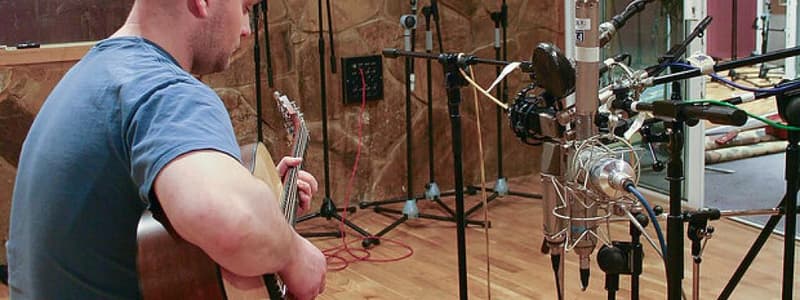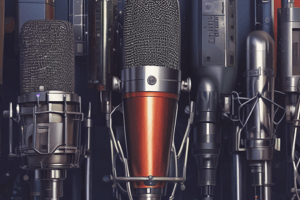Podcast
Questions and Answers
Which type of microphone is known for its durability and ability to handle high sound pressure levels?
Which type of microphone is known for its durability and ability to handle high sound pressure levels?
- Condenser
- Tube
- Ribbon
- Dynamic (correct)
What feature of a microphone allows the user to reduce the bass frequencies in the audio signal?
What feature of a microphone allows the user to reduce the bass frequencies in the audio signal?
- Tube construction
- Pad
- Hi-pass filter (correct)
- Adjustable polar patterns
Which of the following microphones is commonly used for vocals in recording studios?
Which of the following microphones is commonly used for vocals in recording studios?
- Neumann U87 (correct)
- AKG D112
- Shure Beta 52
- AEA R84
What sets the Neumann U87 apart from other microphones?
What sets the Neumann U87 apart from other microphones?
Which microphone is shown in the image?
Which microphone is shown in the image?
Which microphone feature is especially useful for removing low frequency rumble?
Which microphone feature is especially useful for removing low frequency rumble?
Which microphone is shown in the image?
Which microphone is shown in the image?
What is a notable characteristic of dynamic microphones compared to other types?
What is a notable characteristic of dynamic microphones compared to other types?
Which microphone type is commonly found in recording studios due to its cost-effectiveness and robust construction?
Which microphone type is commonly found in recording studios due to its cost-effectiveness and robust construction?
What is the main function of microphones in audio recording?
What is the main function of microphones in audio recording?
What is a characteristic feature of condenser microphones?
What is a characteristic feature of condenser microphones?
Which microphone is shown in the image?
Which microphone is shown in the image?
Which microphone is shown in the image?
Which microphone is shown in the image?
Which microphone has long been a popular mic for voice-over recordings, podcasts, and vocal performances?
Which microphone has long been a popular mic for voice-over recordings, podcasts, and vocal performances?
Which microphones are known for their ability to handle high SPLs?
Which microphones are known for their ability to handle high SPLs?
Which microphone is shown in the image?
Which microphone is shown in the image?
Which microphone is shown in the image?
Which microphone is shown in the image?
Which of the following instruments are commonly recorded with an AKG D112 microphone?
Which of the following instruments are commonly recorded with an AKG D112 microphone?
What is the main advantage of condenser microphones like the Bock 195 or Neumann U87 over dynamic microphones?
What is the main advantage of condenser microphones like the Bock 195 or Neumann U87 over dynamic microphones?
Which microphone is shown in the image?
Which microphone is shown in the image?
What is a key advantage of large diaphragm condenser microphones over small diaphragm condenser microphones?
What is a key advantage of large diaphragm condenser microphones over small diaphragm condenser microphones?
Why are dynamic microphones often preferred for recording vocals in live environments?
Why are dynamic microphones often preferred for recording vocals in live environments?
Which microphone type is most suitable for recording drum overheads to capture the detailed nuances of cymbals?
Which microphone type is most suitable for recording drum overheads to capture the detailed nuances of cymbals?
What makes dynamic microphones like the Shure SM57 ideal for instruments such as guitars and drums?
What makes dynamic microphones like the Shure SM57 ideal for instruments such as guitars and drums?
In what scenarios would a ribbon microphone's figure-8 polar pattern be especially advantageous in a recording studio?
In what scenarios would a ribbon microphone's figure-8 polar pattern be especially advantageous in a recording studio?
What is a common drawback of condenser microphones compared to dynamic microphones?
What is a common drawback of condenser microphones compared to dynamic microphones?
Which microphone is shown in the image?
Which microphone is shown in the image?
Which microphone is shown in the image?
Which microphone is shown in the image?
Which microphone is shown in the image?
Which microphone is shown in the image?
Which microphone is shown in the image?
Which microphone is shown in the image?
Which microphone is shown in the image?
Which microphone is shown in the image?
Which microphone is shown in the image?
Which microphone is shown in the image?
Which microphone is shown in the image?
Which microphone is shown in the image?
Which microphone does the MIRA studio NOT have a pair of? (select the mic that we only have one of)
Which microphone does the MIRA studio NOT have a pair of? (select the mic that we only have one of)
Which microphone is shown in the image?
Which microphone is shown in the image?
Which of the following microphones DOES need phantom power?
Which of the following microphones DOES need phantom power?
Which microphone does NOT require phantom power?
Which microphone does NOT require phantom power?
Which microphone is shown in the image?
Which microphone is shown in the image?
Flashcards
Condenser Microphones
Condenser Microphones
Microphones using a capacitor's electrical properties to detect sound.
Diaphragm
Diaphragm
Thin, lightweight part of a condenser microphone that vibrates with sound.
Backplate
Backplate
Stationary plate that works with the diaphragm in a condenser microphone.
Capacitor
Capacitor
Signup and view all the flashcards
Sound Pressure
Sound Pressure
Signup and view all the flashcards
Microphone Sensitivity
Microphone Sensitivity
Signup and view all the flashcards
Rich Sound
Rich Sound
Signup and view all the flashcards
Fragility of Condenser Mics
Fragility of Condenser Mics
Signup and view all the flashcards
Phantom Power Supply
Phantom Power Supply
Signup and view all the flashcards
Small-Diaphragm Condenser Microphone
Small-Diaphragm Condenser Microphone
Signup and view all the flashcards
Large-Diaphragm Condenser Microphone
Large-Diaphragm Condenser Microphone
Signup and view all the flashcards
Multi-Pattern Condenser Microphone
Multi-Pattern Condenser Microphone
Signup and view all the flashcards
Tube Condenser Microphone
Tube Condenser Microphone
Signup and view all the flashcards
Microphone Placement
Microphone Placement
Signup and view all the flashcards
Shock Mount
Shock Mount
Signup and view all the flashcards
Pop Filter
Pop Filter
Signup and view all the flashcards
Acoustic Treatment
Acoustic Treatment
Signup and view all the flashcards
Sound Source
Sound Source
Signup and view all the flashcards
Recording Space
Recording Space
Signup and view all the flashcards
Sensitivity to Small Sounds
Sensitivity to Small Sounds
Signup and view all the flashcards
Durability of Condenser Mics
Durability of Condenser Mics
Signup and view all the flashcards
Innovative Recording Methods
Innovative Recording Methods
Signup and view all the flashcards
Ambient Sound
Ambient Sound
Signup and view all the flashcards
Polar Patterns
Polar Patterns
Signup and view all the flashcards
Drum Overheads
Drum Overheads
Signup and view all the flashcards
Natural Sound Representation
Natural Sound Representation
Signup and view all the flashcards
Character of Sound
Character of Sound
Signup and view all the flashcards
Recording Vocals
Recording Vocals
Signup and view all the flashcards
Richness in Sound
Richness in Sound
Signup and view all the flashcards
Study Notes
Condenser Microphones
- Operate on a principle different from dynamic microphones, utilizing electrical properties of a capacitor to detect sound.
- Use a thin, lightweight diaphragm that vibrates in response to sound pressure, separated from a stationary metal backplate by a small gap filled with air.
How Condenser Microphones Work
- When sound waves cause the diaphragm to vibrate, the distance between the diaphragm and the backplate changes, altering the capacity of the capacitor.
- The changes in capacity allow the microphone to detect sound waves.
Advantages of Condenser Microphones
- Highly sensitive to sound, capturing subtle nuances and small sound pressure levels.
- Produce a detailed and rich sound, providing a natural and accurate representation of the original sound source.
Disadvantages of Condenser Microphones
- Generally more fragile due to their delicate diaphragm and more sensitive elements.
- Susceptible to damage from physical shock or vibration.
- Require a power source, typically a phantom power supply, to operate.
Types of Condenser Microphones
- Small-Diaphragm Condenser Microphones: Capture high-frequency sounds with precision, often used for recording percussion instruments, drum overheads, and acoustic guitars.
- Large-Diaphragm Condenser Microphones: Improve low-frequency response and capture sounds with warmth and richness, popular for recording vocals, guitar amps, and brass instruments.
- Multi-Pattern Condenser Microphones: Offer flexibility in capturing sound, allowing for switching between multiple polar patterns, often used for recording vocals, drums, and multi-instrument setups.
- Tube Condenser Microphones: Feature vacuum tubes in their circuitry, providing a warm and analog sound, popular among producers and engineers seeking a vintage or retro sound.
Choosing and Using Condenser Microphones
- Consider the type of sound source, desired tone or character, and budget when selecting a condenser microphone.
- Require proper placement, shock mount, and pop filter (when recording vocals) to achieve optimal tone and character.
- Acoustic treatment in the recording space can help control reflections and achieve a more uniform and balanced sound.
Studying That Suits You
Use AI to generate personalized quizzes and flashcards to suit your learning preferences.
Related Documents
Description
Test your knowledge on different types of studio microphones such as dynamic, condenser, ribbon, and tube. Explore features like adjustable polar patterns, hi-pass filter, and pad. Learn about popular studio microphones including AKG C414, Shure SM58, Neumann U87, and more.
This appears public courtesy of St. Petersburg College's MIRA program. Instructor: Dan Hetzel





